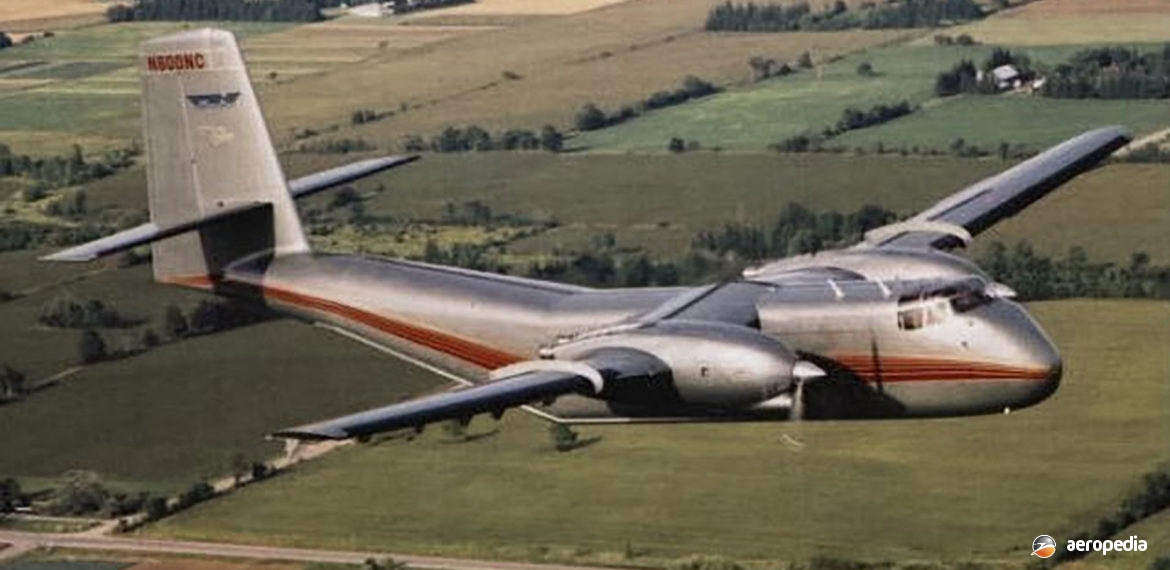Photograph:
Pen Turbo Aviation de Havilland DHC-4 Turbo Caribou N600NC (c/n 237), the first of the Company’s conversions (Pen Turbo)
Country of origin:
Canada
Description:
Commercial transport
Power Plant:
Two 1,062 kw (1,424 hp) Pratt & Whitney PT6A-67T turboprops
Specifications:
- Wingspan: 29.17 m (95 ft 7½ in)
- Length: 22.15 m (72 ft 7 in)
- Height: 9.72 m (31 ft 9 in)
- Wing area: 84.72 m² (912 sq ft)
- Max cruising speed at 3,048 m (10,000 ft): 319 km/h (198 mph)
- Normal cruising speed at 3,048 m (10,000 ft): 287 km/h (178 mph)
- Stalling speed with 40 degrees flap: 104 km/h (64 mph)
- STOL take-off ground run: 244 m (800 ft)
- STOL landing run: 335 m (1,100 ft)
- Rate of climb: 463 m/min (1,520 ft/min)
- Single engine ceiling: 3,658 m (12,000 ft)
- Range at normal cruising speed: 1,519 km (944 miles)
- Loaded weight: 12,928 kg (28,500 lb)
- Max zero fuel weight: 12,247 kg (27,000 lb)
- Max payload: 4,536 kg (10,000 lb)
- Max fuel in internal tanks: 2,513 kg (5,540 lb)
History:
Under a supplemental type certificate, Pen Turbo Aviation of Cape May Airport, New Jersey early in the 21st century undertook a re-engineering of the DHC-4A Caribou as a result of market demand for a turbine-powered variant of the Caribou. The conversion replaced the Pratt & Whitney R-2000 piston engines with the same Company’s Canadian-built PT6A-67T unit, the turbine engines increasing overall performance, reducing the basic weight whilst the normal take-off weight remained at 12,928 kg (28,500 lb), giving a payload of 4,536 kg (10,000 lb).
The Company has converted a number of Caribous to turbine power, and these have included N54NC (c/n 49), N55NC (c/n 61), N53NC (c/n 263), N52NC (c/n 26), N51NC (c/n 261), N56NC (c/n 133), N57NC (c/n 72), N82NC (c/n 72), N84NC (c/n 284) and N86NC (c/n 286). In the 1990s the Company obtained a number of retired aircraft, some ex-civil aircraft, some 20 or so from the Spanish Air Force, and a number from India.
In early 2010 Caribou Cargo of Queensland announced it had obtained a Caribou STOL transport fitted with turboprops to perform freight work in Australia, Papua-New Guinea and Asia where loads of up to 4,500 kg (9,921 lb) could be carried to small or unprepared airstrips, the aircraft being obtained from Pen Turbo, this aircraft fitted with PT6A-67T engines. However, by early 2019 the aircraft is not known to have arrived in Australia and the position as to its importation is not known.
However, further conversions have taken place, these including N238PT (c/n 238) and N303PT (c/n 303), the latter operating in rugged mountainous areas in Papua, taking up duties at Ilaga in 2016. N238PT operated in Haiti during emergencies in the area. In May 2016 N303PT became PK-SWW to Alfa Indonesia and was delivered to Ilaga Airport in Indonesian Papua. However, on 31 October that year it was on a charter flight from Tembagapura Airport to Ilaga Airport when it crashed into a mountain 11 km (7 miles) from Ilaga at a height of 3,962 m (13,000 ft) and was destroyed.
It is interesting to note that at one stage the RAAF was considering replacing the piston engines in its Caribous with the PT6 and an investigation of this was carried out, this being known as the “Tango Charlie” option. It was stated at the time the “Tango Charlie” proposal was unique as it was based on an existing, proven, flight-tested and certificated conversion design and would not incur risks associated with a new design. It also included other improvements resulting in the Caribou’s utility and value.
An analysis in 2000 indicated that a retrofit of the RAAF fleet would be revenue neutral against current operating costs within a five to eight year timeframe. It was found that with a fleet of Turbo Caribous No 38 Squadron’s effective strength would increase by over 25% as the achievable 96% availability would permit a significantly higher flying rate and rate of sorties completion. It was also found further refurbished aircraft modified to this configuration would be a credible option, and with initial in-country conversions there would be no loss of aircraft availability at the outset of any conversion program. However, the project did not go ahead and the RAAF Caribou fleet was retired in late 2009, eventually replaced by the Alenia C -27J Spartan.

